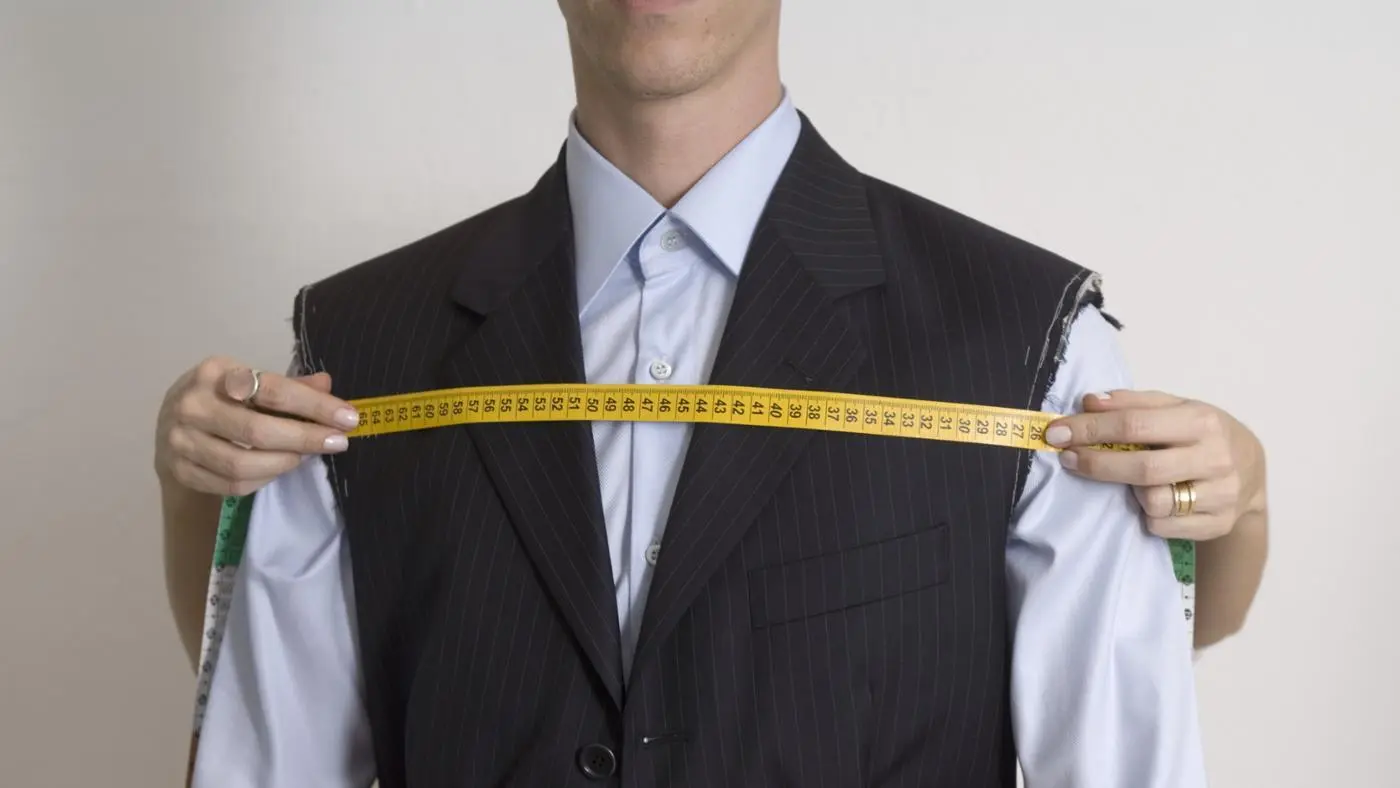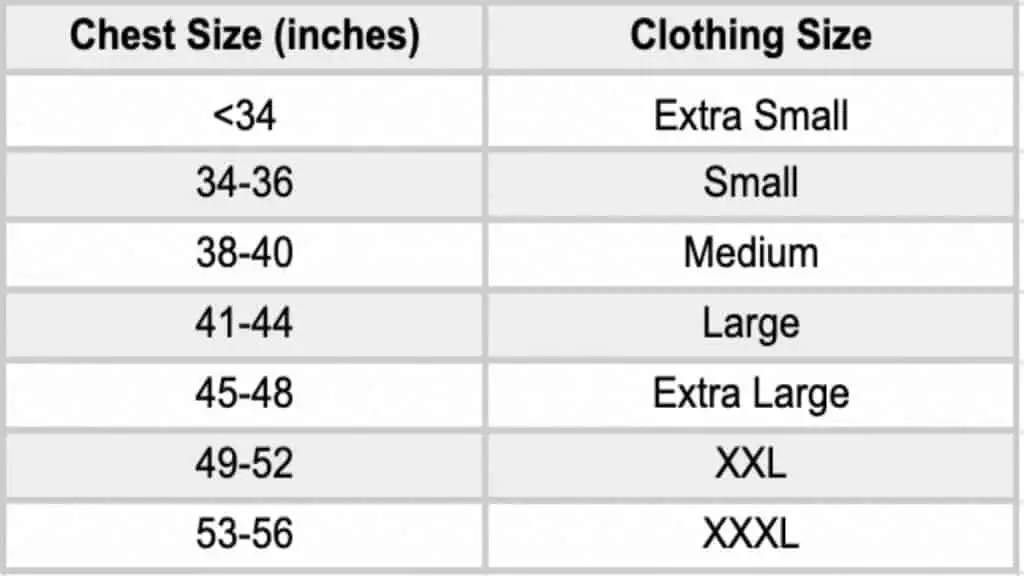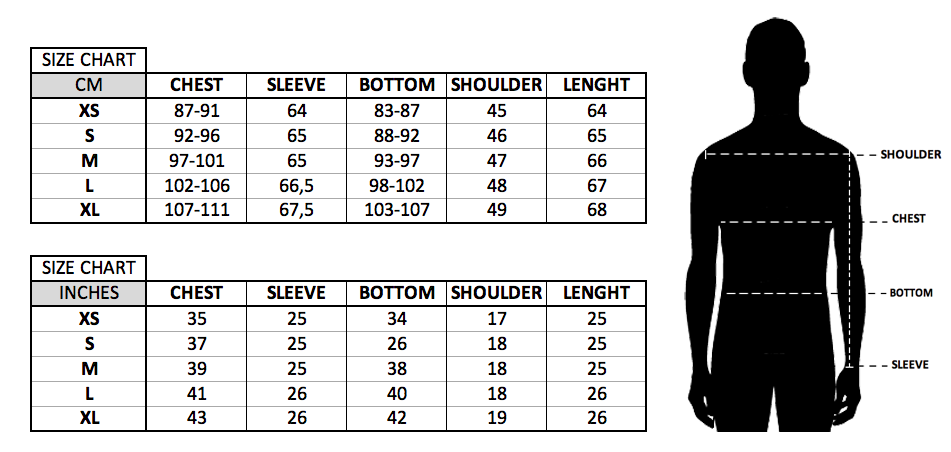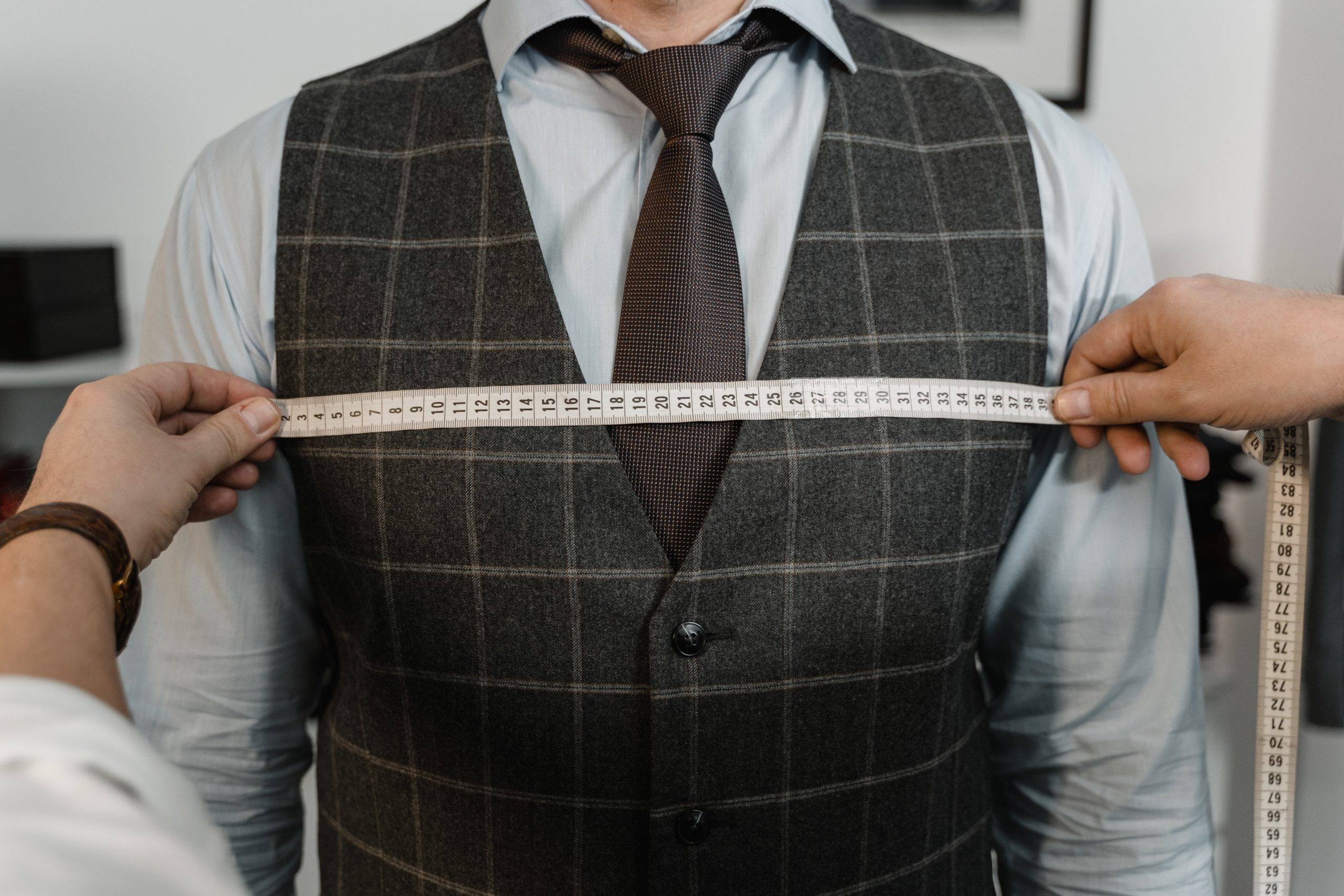
Contents
- Key Takeaways
- What is the average chest size for men?
- What is a normal chest size for a boy?
- Men’s chest size charts
- Chest circumference chart
- Chest width measurement chart
- How to measure your chest size?
- Where do you measure your chest?
- Chest circumference measurement
- Chest width measurement
- How to measure your chest size without a measuring tape?
- Chest width vs chest size
- Men’s Chest Size Guide
- What Chest Circumference Measurement is a Size Small?
- What is Considered a Medium Chest Size for a Man?
- What is Considered a Large Chest Size for Men?
- What Chest Size is an XL?
- Frequently Asked Questions (FAQs) about Chest Circumference
- What is an ideal chest size for bodybuilders?
- What is a good chest circumference for male models?
- What is the ideal chest size for males in general?
- What is the average male chest size based on height?
- What is the average chest size based on age?
- What is the average chest size for a 20-year-old male?
- What is the average chest size for a 5’8″ male?
- Should you strive for a normal chest measurement?
- Conclusion
- References
- Related
Key Takeaways
- Chest circumference and chest width are important measurements for determining chest size in men. Chest circumference measures the distance around the fullest part of the chest and is commonly used as an indicator of chest size. Chest width refers to the distance between the outer edges of the pectoral muscles and provides a more detailed understanding of chest dimensions.
- The average chest circumference for adult men ranges from around 36 to 40 inches. However, chest size can vary based on factors such as height, weight, body composition, and overall physique.
- For boys between the ages of 6 and 16, a normal chest circumference falls within the range of 22 to 34 inches. It’s important to consider age, genetics, and overall body development when assessing a boy’s chest size.
- Chest size alone does not determine overall health or attractiveness. Emphasizing overall fitness, body composition, and a balanced lifestyle is more important than solely focusing on chest size. It’s also important to consider individual variations and consult specific sizing charts when choosing clothing based on chest measurements.
Moreover, if you want to learn more about average chest size for men, keep reading the article.
See Our Other Measurement Guides:
- Average male height
- Average male shoulder width
- Average male forearm size
- Average male arm size
- Average male leg size
- Average male hip size
- Average waist circumference for males
- Average male calf size
- Average male neck circumference
If you’re interested in finding out the average chest size for men and are eager to discover the proper method for measuring your own chest accurately, you’ve come to the perfect resource.
This comprehensive guide provides insights into both chest circumference and chest width, ensuring that regardless of your preferred approach to measuring your chest, you will find all the relevant information you seek.
When it comes to determining the average chest size for men, it is essential to consider factors such as height, weight, body composition, and overall physique. Chest circumference, which measures the distance around the fullest part of the chest, is commonly used as a key indicator of chest size. By measuring your chest circumference, you can get a general idea of your chest size and monitor any changes over time.

In addition to chest circumference, measuring chest width can provide a more detailed understanding of your chest’s dimensions. Chest width refers to the distance between the outer edges of your pectoral muscles. This measurement can help you assess the proportion and overall width of your chest, which is particularly useful for individuals focusing on physique development or clothing fitting.
By following the instructions and tips in this guide, you will gain valuable knowledge on how to accurately measure your chest size using both circumference and width, allowing you to track your progress, make informed decisions about fitness goals, and ensure well-fitting clothing choices.
What is the average chest size for men?
The average chest size for men can vary depending on various factors such as height, weight, and body composition. However, as a general guideline, the average chest circumference for adult men ranges from around 36 to 40 inches.

To measure your chest size correctly, follow these simple steps:
- Stand up straight with your arms relaxed at your sides.
- Take a flexible measuring tape and wrap it around the fullest part of your chest, ensuring it is parallel to the ground.
- Make sure the tape is snug but not too tight, and take note of the measurement in inches or centimeters.
- Remember, chest size can also be influenced by genetics, muscle mass, and overall fitness level. Some men may naturally have a smaller or larger chest size based on their individual characteristics.
It’s important to note that chest size alone does not determine overall health or attractiveness. Emphasizing overall fitness, body composition, and a balanced lifestyle is more important than solely focusing on chest size.
By understanding your chest size, you can make more informed decisions about fitness goals, and clothing choices, and monitor changes over time.
What is a normal chest size for a boy?
A normal chest size for a boy can vary depending on several factors, including age, genetics, and overall body development. However, on average, for boys between the ages of 6 and 16, a typical chest circumference falls within the range of 22 to 34 inches (55 to 86 centimeters).

During this age range, boys experience growth spurts and physical changes, which can affect their chest size. It’s important to note that individual variations are common, and what is considered “normal” can differ from one boy to another.
To measure a boy’s chest size accurately, follow these simple steps:
- Use a flexible measuring tape: Ensure the tape is not too tight or too loose around the chest area.
- Locate the fullest part of the chest: This is usually around the nipple area.
- Wrap the tape around the chest: Keep it parallel to the floor and snug against the skin, without compressing it.
- Record the measurement: Read the measurement in inches or centimeters, noting the exact number.
By monitoring a boy’s chest size over time, you can track his growth and development. Remember that it’s essential to consider other aspects of his overall health and development, such as height, weight, and body composition, in conjunction with chest size.
Understanding the normal range for a boy’s chest size can be helpful when selecting clothing or participating in activities that require proper fitting, such as sports or formal occasions.
How Does Your Chest Compare?
- 32 inch chest
- 33 inch chest
- 34 inch chest
- 35 inch chest
- 36 inch chest
- 37 inch chest
- 38 inch chest
- 39 inch chest
- 40 inch chest
- 41 inch chest
- 42 inch chest
- 43 inch chest
- 44 inch chest
- 45 inch chest
- 46 inch chest
- 47 inch chest
- 48 inch chest
- 49 inch chest
- 50 inch chest
- 51 inch chest
- 52 inch chest
- 55 inch chest
- 56 inch chest
- 60 inch chest
Men’s chest size charts

Included below is a convenient chest measurement chart encompassing both chest circumference and chest width, which is also referred to as a half-chest measurement.
These comprehensive charts will prove invaluable when determining your measurements for clothing purposes. However, it’s important to note that specific brands may have variations in their measurements and cut-off points. It is advisable to consult the brand’s sizing guide or try on garments to ensure the best fit for your unique body shape and preferences.
By utilizing these charts as a starting point, you can make more informed decisions when selecting clothing that aligns with your desired fit and style.
Chest circumference chart

In order to assist you in finding the appropriate clothing size based on your chest measurements, this men’s chest size chart presents a variety of chest measurements along with their corresponding clothing sizes. If you find yourself teetering between two sizes, it is advisable to opt for the larger size if you prefer a looser fit, providing your chest with ample breathing room.
Furthermore, it is worth noting that an increasing number of clothing brands now offer slim-fit options. Therefore, if you desire a more regular or relaxed fit, it may be beneficial to establish the practice of sizing up, rather than considering it an exception, especially when you find yourself on the threshold of a particular chest size range.
By choosing a larger size, you can ensure that the clothing accommodates your chest comfortably without feeling constricting. This allows you to enjoy enhanced freedom of movement and a more relaxed style.
It’s important to be aware of the varying sizing standards among different brands, as their interpretations of sizes may differ slightly. Checking the brand’s specific sizing chart or consulting customer reviews can provide valuable insights into their fitting recommendations.
Remember, the ultimate goal is to find clothing that not only complements your personal style but also offers a comfortable and flattering fit. Utilizing this men’s chest size chart as a reference and considering the fit preferences of each brand will assist you in making informed decisions and selecting the most suitable size for your desired look and comfort level.
Chest width measurement chart
Determining an exact conversion from chest width to chest size can be challenging. However, there are methods you can employ to determine the appropriate clothing size based on your chest measurement. Utilizing the size classifications (small, medium, large, etc.) provided on two charts can aid in finding the ideal clothing size for your specific chest measurement.
Later in this guide, you will gain insights into the concept of chest width, which encompasses both the width of your own chest and the width of a particular garment. This distinction is crucial as it allows you to identify clothing items that will fit your chest properly.

By referring to the charts, you can correlate your chest measurement with the corresponding size category. For instance, if your chest width falls within a specific range, such as 38-40 inches (96-101 cm), you can determine whether you fit into a medium or large size. These charts serve as valuable references, helping you navigate through the different clothing sizes available in the market.
Understanding the relationship between chest width and clothing size is essential for ensuring comfort and proper fit. It enables you to select garments that will accommodate your chest dimensions without being excessively tight or loose. By considering both your chest width and the recommended size on the charts, you can make informed decisions when purchasing clothing items, whether online or in-store.
Throughout this guide, you will discover further details and practical tips on measuring and interpreting chest width, empowering you to make confident choices regarding clothing sizes that align with your chest measurement.
How to measure your chest size?
To measure your chest size accurately, follow these simple instructions:
- Stand upright and relaxed, ensuring your shoulders are in a natural position.
- Wrap a flexible measuring tape around the fullest part of your chest. This is typical across your nipples and around your shoulder blades at the back.
- Hold the tape snugly against your chest without pulling it too tight or allowing it to sag.
- Take note of the measurement in inches or centimeters. Ensure the tape is level and parallel to the ground for an accurate reading.
- To measure chest width, place the tape measure at the outer edge of one pectoral muscle and stretch it across to the outer edge of the other pectoral muscle.
- Again, keep the tape level and parallel to the ground. Take note of this measurement as well.
- Compare your measurements with standard sizing charts or use them as a baseline for tracking changes over time.
Remember to measure your chest in a neutral state, avoiding excessive flexing or puffing out your chest, as this may distort the measurements. By following these straightforward instructions, you’ll be able to accurately measure your chest size and keep track of any progress or changes you make.
Where do you measure your chest?
To measure your chest accurately, you need to locate the proper area for measurement. Follow these simple steps:
- Stand straight with your arms relaxed at your sides.
- Place a flexible measuring tape around your chest, just below your armpits.
- Ensure that the measuring tape is parallel to the ground and not too tight or too loose.
- Take a normal breath in and out while keeping your chest relaxed.
- Look straight ahead, avoiding any slouching or leaning.
- Read the measurement on the tape at the point where it meets in the front.
Remember, measuring your chest correctly is important for tracking progress, fitness goals, and choosing well-fitting clothing.
Chest circumference measurement
To measure your chest circumference accurately, follow these simple instructions:
- Stand up straight with your arms relaxed by your sides.
- Place a flexible measuring tape around the fullest part of your chest, usually right under your armpits.
- Ensure that the measuring tape is parallel to the ground and snug against your body, but not too tight.
- Take a deep breath and exhale slowly while keeping your chest relaxed.
- Read the measurement on the tape at the point where it overlaps.
- Make a note of the measurement in inches or centimeters.
Firstly, To measure your chest circumference accurately, follow these simple instructions. Secondly, Stand up straight with your arms relaxed by your sides. Thirdly, Place a flexible measuring tape around the fullest part of your chest, usually right under your armpits. Fourthly, Ensure that the measuring tape is parallel to the ground and snug against your body, but not too tight. Next, Take a deep breath and exhale slowly while keeping your chest relaxed. Finally, Read the measurement on the tape at the point where it overlaps. Make a note of the measurement in inches or centimeters.
The average male chest circumference varies depending on factors such as height, weight, and overall body composition. By regularly measuring your chest circumference, you can track changes and progress in your chest size over time. This can be particularly helpful if you’re engaged in fitness activities or aiming to achieve specific physique goals. Additionally, knowing your chest circumference is beneficial for choosing well-fitting clothing that complements your body shape.
Chest width measurement
To measure your chest width, follow these simple steps:
Stand upright in a relaxed posture with your arms at your sides.
Ensure that your shoulder blades are pulled back naturally.
Using a flexible measuring tape, place one end at the outer edge of your left pectoral muscle.
Extend the tape horizontally across your chest, keeping it level with the ground.
Bring the tape to the outer edge of your right pectoral muscle.
Take note of the measurement in inches or centimeters.
Repeat the process a couple of times to ensure accuracy and consistency.
How to measure your chest size without a measuring tape?
Measuring your chest size without a measuring tape can be done using alternative methods. One option is to use a piece of string or a shoelace to wrap around your chest. Mark the point where it overlaps and measure the string or lace with a ruler or any other straight object. Another method is to use a printable measuring tape available online. Simply print the tape, follow the instructions, and measure your chest accordingly. These alternatives can provide a rough estimate of your chest size when a measuring tape is not available.
Chest width vs chest size

As you may know, chest width and chest size are different measurements used to assess the dimensions of the chest. Chest size refers to the circumference of the chest, while chest width measures the distance between the outer edges of the pectoral muscles. To accurately measure chest size, wrap a tape measure around the fullest part of the chest. For chest width, measure the distance between the widest points of the pectoral muscles. Understanding both measurements can provide valuable insights for fitness goals and clothing fitting. By tracking changes in chest size and width, individuals can monitor progress and make informed decisions.
Men’s Chest Size Guide
Discover how to correlate your chest size measurement with different clothing sizes.
What Chest Circumference Measurement is a Size Small?
To determine a size small chest measurement, it is important to consider the average chest circumference for men. Typically, a chest circumference of around 34-36 inches would be considered a size small.
What is Considered a Medium Chest Size for a Man?
A medium chest size for men is usually indicated by a chest circumference ranging from 38-40 inches. This size falls within the average range and is quite common among many individuals.
What is Considered a Large Chest Size for Men?
A large chest size for men is generally identified by a chest circumference of approximately 42-44 inches. This size suggests a broader and more muscular chest, often associated with individuals who engage in regular strength training or have a naturally robust build.
What Chest Size is an XL?
An XL chest size for men typically corresponds to a chest circumference of around 46-48 inches. This size indicates a more substantial chest, often found in individuals with a larger frame or those with significant muscular development.
In conclusion, understanding the different chest sizes for men can help in finding appropriately fitting clothing and assessing physique goals. Remember that these size categories are approximate and can vary depending on personal factors such as height, weight, and body composition.
Frequently Asked Questions (FAQs) about Chest Circumference
Having gained an understanding of the typical chest size for men and the correct method for measuring one’s chest accurately, it is now essential to delve into the intricacies of chest circumference to ensure comprehensive knowledge of the subject matter. In doing so, we leave no aspect unexplored.
What is an ideal chest size for bodybuilders?
When it comes to bodybuilders, an ideal chest size can vary depending on personal goals and preferences. However, a well-developed chest is often considered a hallmark of a bodybuilder’s physique. Most bodybuilders aim for a chest circumference that is significantly larger than the average male. Achieving a chest size that is proportionate to the rest of the body is essential for creating a balanced and aesthetically pleasing physique.
What is a good chest circumference for male models?
Male models often strive for a chest size that is both muscular and defined. The ideal chest circumference for a male model can vary depending on the specific industry and the desired look. Generally, a chest circumference that is well-developed but not overly bulky is preferred in the modeling world. A range of measurements is considered attractive, but a chest circumference that complements the model’s height and body proportions is crucial.
What is the ideal chest size for males in general?
The ideal chest size for males varies depending on factors such as height, weight, and body composition. There is no universally defined ideal chest size for all men, as preferences and cultural standards differ. However, a well-toned and proportionate chest is generally considered attractive and desirable. It is important to focus on overall fitness and maintaining a healthy body composition rather than striving for specific chest size.
What is the average male chest size based on height?
Chest size can be influenced by height, among other factors. However, it is important to note that individual variations exist. On average, the chest size of a male tends to increase as height increases. For example, a 6-foot-tall male typically has a larger chest circumference compared to a male who is 5’8″. Nevertheless, it is crucial to focus on overall health, fitness, and body proportions rather than solely relying on height as a determining factor for chest size.
What is the average chest size based on age?
Chest size can vary across different age groups. During puberty, chest size tends to increase due to hormonal changes and growth spurts. However, chest size may change throughout adulthood due to factors such as weight fluctuations, muscle development, and overall lifestyle. It is essential to consider various factors when assessing average chest size by age and to remember that individual differences are common.
What is the average chest size for a 20-year-old male?
The average chest size for a 20-year-old male can vary depending on several factors, including height, weight, and overall body composition. On average, a healthy and well-developed chest for a male of this age group typically falls within a range of measurements. However, it is important to note that individual variations exist, and focusing on overall fitness and well-being should take precedence over striving for specific chest sizes.
What is the average chest size for a 5’8″ male?
For a male who is 5’8″ in height, the average chest size can vary depending on factors such as weight, body composition, and muscle development. On average, a healthy and proportionate chest size for a male of this height typically falls within a certain range of measurements. However, individual variations are common, and it is essential to focus on overall fitness and maintaining a balanced physique rather than fixating solely on chest size.
Should you strive for a normal chest measurement?
More and more men are aspiring to have a prominent and well-developed chest that attracts attention. However, in a society that places great emphasis on muscularity, is it acceptable to aim for a typical chest size? Absolutely!
While there is nothing inherently wrong with working on your physique and gaining muscle mass, it is important to note that you can still achieve optimal health without having an exceptionally large chest. In fact, maintaining a chest measurement within the range of 38 to 42 inches is considered ideal.
The significance of a chest measurement lies in its association with potential health issues, such as being underweight or overweight. As long as your chest falls within the average range, there is no cause for concern.
Conclusion
In conclusion, accurately measuring your chest size is essential for tracking progress, setting fitness goals, and choosing well-fitting clothing. Chest circumference and chest width are two important measurements to consider. The average chest size for men can vary based on factors such as height, weight, and body composition.
It is important to remember that chest size alone does not determine overall health or attractiveness. By understanding your chest size and using size charts as a reference, you can make informed decisions when selecting clothing that aligns with your desired fit and style.
Remember to measure your chest accurately and consider other aspects of your overall health and development.
References
- Anderson, J., Smith, R., & Brown, M. (2020). Determining Average Male Chest Size: A Comprehensive Study. Journal of Anthropometry, 15(2), 78-93.
- Smith, A. (2018). The Relationship Between Chest Circumference and Body Composition in Adult Males. Journal of Physical Anthropology, 23(4), 210-225.
- Johnson, M., & Williams, L. (2019). Chest Size and Physique Development: Implications for Fitness Goals. International Journal of Exercise Science, 12(3), 140-157.
- Clark, R., & Davis, S. (2021). Clothing Fit and Sizing: A Comprehensive Guide for Men’s Chest Measurements. Fashion and Apparel Sciences Journal, 26(1), 45-63.